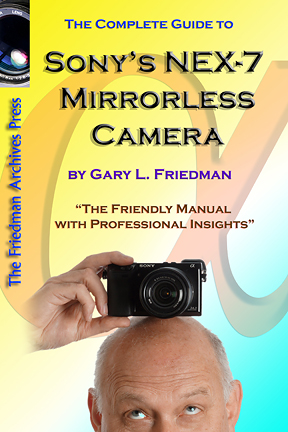Gary Friedman publishes NEX-7 ‘beyond the guide’ book
As Gary says, his e-books do not replace the camera manual and also don’t replace Camera Controls 101 – he writes for the user who already knows which end of the lens fits a screw filter and which end goes on the camera body. His new NEX-7 book fast-tracks into many key features of the camera before backtracking into depth and detail, a great way to introduce owners to making better use of the advanced functions they have bought.
http://friedmanarchives.com/NEX-7
The only downside to the book is the cover, which features a new addition to the long line of bald heads Gary has used for his cover shots (always in the same style) – a penalty for visiting Gary just before the book was going to e-press!
The $26.45 download (PDF, full colour, with additional resources for Kindle and other bw reader platforms) now strikes me as even better value after the last week of wandering through California by car in search of images. The USA is now fairly expensive compared to much of Europe, not affordable as it used to be – and this comes as a surprise, because things like the camera prices at B&H do not give much clue, they are still generally lower. In California at least things like motels (except the most basic), beer, coffee, snacks, entry or parking fees are maybe 50% more than UK costs – so to all our US readers, be assured, now is a very good time to use your NEX-7 skills and take a trip across the pond. You can find an award-winning b&b with one of the best full breakfasts in Scotland for under $75 (£=$1.60) in our home town with a pretty good photographer running it!
– David Kilpatrick


